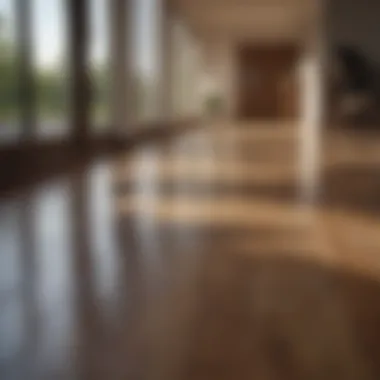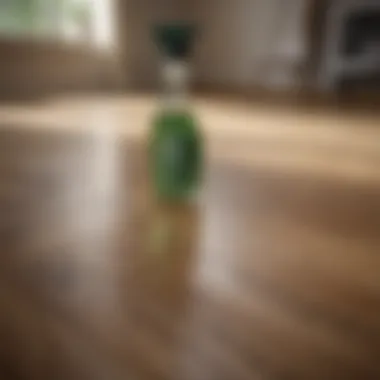Effective Cleaning Strategies for Laminate Floors


Intro
Cleaning laminate floors effectively requires an understanding of the material and the best practices to maintain its integrity. Unlike hardwood or tile, laminate flooring has specific cleaning needs that, if neglected, can lead to damage. This guide will provide insights into effective cleaning strategies that help maintain the floor’s durability and appearance, ensuring it continues to be a beautiful element of any room.
One of the main challenges with laminate flooring is its susceptibility to moisture. While laminate can handle minor spills, prolonged exposure can warp the material. Furthermore, using the wrong cleaning solutions can cause discoloration or even permanent damage. Educating oneself about the suitable cleaning methods is crucial.
Home Features
Architectural Marvels
Laminate floors can enhance the aesthetic appeal of various architectural styles. From modern minimalist spaces to classic traditional homes, the right laminate can complement any interior. Its versatility makes it an excellent choice for homeowners exploring different decors.
Unique Design Elements
When decorating with laminate floors, consider the texture and finish. High-gloss finishes can provide a sleek look, while textured laminate may add warmth and character. The choice of color also plays a significant role. Light shades can make a space look larger, while darker tones add depth. When choosing laminate, it is essential to consider how these design elements will interact with other features in the home.
Using laminate flooring can elevate the design of your home while offering practicality in maintenance.
Cleaning Techniques for Laminate Floors
Suitable Cleaning Solutions
Selecting the right cleaning solution is fundamental. Here are some options that work well for laminate:
- pH-balanced cleaners: These are specifically formulated for laminate and can clean effectively without causing damage.
- Distilled water and vinegar mixture: A homemade solution of one cup of vinegar to a gallon of water can help maintain shine.
- Commercial laminate floor cleaners: Brands like Bona and Armstrong offer cleaning solutions specifically designed for laminate surfaces.
Essential Tools
Using the right tools is key to effective cleaning. Consider the following:
- Microfiber mop: These are gentle on the surface and can absorb dirt effectively.
- Soft-bristle broom: Ideal for sweeping away debris without scratching the floor.
- Vacuum cleaner with a hard floor setting: This can remove dust and dirt more thoroughly than sweeping alone.
Cleaning Techniques
To keep laminate flooring in optimal condition, follow these steps:
- Sweep or vacuum regularly to remove dirt and debris.
- Use a damp mop with an appropriate cleaner. Avoid soaking the floor.
- Wipe up spills immediately to prevent moisture damage.
- Do not use abrasive cleaners or scrubbing pads, as these can scratch the surface.
Frequency of Cleaning
While you should sweep or vacuum at least once a week, deep cleaning should occur every few months. As the foot traffic in your home fluctuates, adjust the cleaning frequency based on the condition of your floors.
Culmination
Preamble to Laminate Flooring
Laminate flooring has gained significant popularity in recent years due to its combination of affordability and aesthetic appeal. Understanding its relevance is crucial for homeowners and interior design enthusiasts alike. This article seeks to explore laminate flooring in depth, focusing on effective cleaning strategies that can enhance its durability.
Composition and Structure of Laminate Floors
Laminate floors are primarily composed of several layers, which collectively form a highly durable surface. The top layer is a transparent wear layer made of a durable material, usually made of melamine resin. Beneath this, there is a printed design layer, which mimics the appearance of wood, stone, or other materials. The core layer is made of high-density fiberboard (HDF), providing stability and resistance to moisture. Finally, the backing layer ensures the floor is moisture-resistant and prevents warping. Understanding this composition is vital, as it informs the best cleaning methods, helping prevent damage and maintain the look of your flooring.
Advantages of Laminate Flooring
The advantages of laminate flooring are considerable. First, it is cost-effective compared to traditional hardwood flooring. Laminate floors provide a similar aesthetic without the higher price point. Second, they are easy to install, often featuring a click-lock system that simplifies the process for DIY enthusiasts.
This type of flooring is also resistant to staining and fading, making it suitable for high-traffic areas. Furthermore, its maintenance requires minimal effort; simple regular cleaning can keep it looking new for years. The durability of laminate against scratches and dents is another significant plus.


Common Misconceptions about Laminate Flooring Care
Many misconceptions exist regarding laminate flooring care. Some people erroneously believe that laminate floors can withstand excessive water exposure without damage. In reality, while they can resist some moisture, prolonged exposure can lead to warping.
Another common belief is that harsh chemicals are necessary for effective cleaning. In truth, many laminate-friendly cleaning solutions exist that can effectively clean without risking the integrity of the floor finish. Additionally, some individuals assume that vacuuming is harmful due to the risk of scratching; however, vacuuming with a proper attachment can be safe and beneficial for maintaining cleanliness.
Proper knowledge about the care and characteristics of laminate flooring is essential for ensuring its longevity and aesthetic value. By addressing these topics, readers can form a holistic understanding that aids in making informed decisions regarding their laminate floors.
Understanding the Challenges of Cleaning Laminate Floors
Cleaning laminate floors could seem simple, but various challenges demand understanding and strategic approaches. This section explores those challenges, addressing common issues that arise and the importance of recognizing them. Key factors such as stain types, avoidance of damage, and environmental aspects play a vital role in maintaining laminate flooring.
Identifying Stains and Dirt Types
Different stains and dirt types require specific cleaning techniques. Laminate floors often attract dust, pet hair, and other debris. Common stains can include food, drink, or dirt tracked in from outside. Identifying the source of stains is essential for effective cleaning. For instance, sticky substances from spilled drinks need special attention compared to dirt brought in from the outdoors.
Knowing the difference helps in selecting appropriate cleaning methods. For more persistent stains, pre-treating with suitable solutions can improve results. Pay attention to the particular finish of your laminate. Some finishes may be more susceptible to certain cleaning agents. This understanding can save time and maintain the floor’s appearance.
Avoiding Damage during Cleaning
Maintaining the integrity of laminate floors is crucial. Some cleaning practices can inadvertently cause harm. For example, excessive water can seep into seams, leading to warping. Using abrasive cleaners or tools can create scratches that dull the surface, impacting the overall aesthetics.
To avoid damage:
- Use a damp mop instead of a soaking one.
- Choose non-abrasive cleaning tools.
- Avoid heavy-duty scrubbing pads.
Taking preventive steps enhances the longevity of your floors. Always choose cleaning methods designed specifically for laminate surfaces. Read product labels to ensure compatibility. Awareness of these considerations protects your investment and keeps the floor looking its best.
Environmental Considerations
Cleaning practices can also have implications for the environment. Many cleaning solutions contain chemicals that may affect indoor air quality. Opting for eco-friendly products minimizes impact. This not only factors for health but also contributes to broader environmental goals.
When cleaning laminate floors:
- Consider using biodegradable cleaners.
- Reuse cleaning materials when possible.
- Dispose of non-recyclables responsibly.
Taking note of these practices adds a layer of responsibility to cleaning routines. Conscious choices benefit both the home environment and the earth.
In summary, understanding the challenges related to cleaning laminate floors empowers homeowners to maintain them effectively. Recognizing stain types, avoiding damage, and considering environmental impact can ultimately extend the lifespan of laminate flooring.
With a solid foundation in these challenges, readers can approach the subsequent cleaning methods with confidence.
Best Cleaning Methods for Laminate Floors
When it comes to maintaining laminate floors, utilizing effective cleaning methods is paramount. These methods not only enhance the appearance of the floor but also prolong its life. Laminate flooring requires specific care due to its unique composition. Understanding the best cleaning methods ensures you can keep your floors looking their best without causing unnecessary damage. Key considerations include the type of debris, frequency of cleaning, and the tools used. Proper cleaning can prevent scratches and loss of sheen.
Sweeping vs. Vacuuming
Both sweeping and vacuuming are essential for cleaning laminate floors. Sweeping removes loose dirt and debris effectively when done regularly. A soft-bristled broom is recommended to prevent scratching the surface. However, vacuuming can offer a deeper clean, especially with fine particles. It is important to choose a vacuum without a beater bar, which can damage the laminate. Ideally, alternating between sweeping and vacuuming will yield the best results.
Using Damp Mops Effectively
Damp mopping is a useful technique for removing stains and spots. When using a damp mop, it is vital to use minimal water. Excess water can seep into the seams of laminate flooring, leading to warping and damage. Opt for a microfiber mop because it attracts dirt effectively. It is advisable to use a cleaning solution specifically designed for laminate floors. This helps to maintain the gloss and texture.
Choosing the Right Cleaning Solutions
Selecting the right cleaning solution plays a critical role in maintaining laminate floors. Certain solutions can leave residues that dull the finish or cause damage. It's best to avoid harsh chemicals and alkaline cleaners. Instead, consider gentle, pH-balanced cleaners or products that are recommended for laminate surfaces. Reading product labels is crucial to avoid harmful ingredients that can reduce the lifespan of your flooring.


Commercial Cleaners vs. DIY Solutions
Both commercial cleaners and DIY solutions have their advantages. Commercial cleaning products are designed specifically for laminate floors and often include protective agents. However, DIY solutions can be effective and economical. A mixture of water and vinegar can work as a natural cleaner, provided it is used in moderation. Understanding the pros and cons of both methods will help you tailor the cleaning approach to your needs.
Recommended Tools for Cleaning Laminated Floors
Choosing the right tools for cleaning laminate floors is crucial for maintaining their aesthetic and structural integrity. The wrong tools may cause scratches and other damage. Effective cleaning not only preserves appearance but also prolongs the floor's life.
Investing in proper cleaning tools can simplify the maintenance process and enhance overall performance. This section will delve into specific cleaning tools that are best suited for laminate flooring, highlighting the unique characteristics and advantages of each type.
Microfiber Mops and Pads
Microfiber mops are increasingly popular for laminate floor cleaning. These mops have fibers that are very fine, allowing them to capture dust and dirt effectively. Unlike traditional mops, microfiber mops do not require excessive water to clean, which is particularly important for laminate surfaces that can be damaged by excessive moisture.
Using microfiber pads can ensure that no streaks are left behind after cleaning. These pads are generally washable and reusable, making them an eco-friendly option. Regularly changing or washing the pads is key to maintaining cleaning efficiency and preventing accumulation of bacteria or soil.
Brooms and Vacuum Cleaners
A good broom or vacuum cleaner can make a significant difference in routine cleaning. Brooms designed specifically for hard surfaces can help remove loose dirt and debris before deeper cleaning. A quality vacuum cleaner is also essential, particularly those equipped with soft bristles and no-beater bars. This helps avoid scratches and ensures thorough dirt removal, even from crevices.
When selecting a vacuum cleaner, consider options that offer a hardwood floor setting. This setting often has lower suction power to avoid damaging the floor while still providing adequate cleaning capabilities.
Bucket and Water Management
Water management is an often-overlooked aspect of cleaning laminate floors. When using a mop, it is vital to control the amount of water applied. Over-saturation can lead to water seeping into seams, causing swelling and damage over time.
Using a bucket with a wringer or measuring system can help manage how much water is used on the mop. This allows for a damp mop, which effectively cleans the surface while minimizing water application. Proper water management ensures that the laminate remains pristine without risking long-term damage.
Step-by-Step Cleaning Process
A methodical approach to cleaning laminate floors is essential for achieving optimal results. This step-by-step cleaning process ensures that every part of the floor is addressed thoroughly. A consistent routine prevents dirt and grime build-up while protecting the surface from potential damage. Understanding this process can lead to not only a cleaner floor but also prolong its life.
Preparing the Space
Before initiating the cleaning process, it is crucial to prepare the environment. First, remove any furniture or objects that might obstruct access to the floor. Clearing the area effectively allows for a thorough cleaning without interruptions. It also reduces the risk of accidents or damage to your belongings during the cleaning.
Next, inspect the surface for any loose debris. Use a broom or a vacuum with a soft brush attachment to remove dust, hair, or other particles. This initial step is vital, as it prevents scratching the laminate during deeper cleaning. Ensure that the vacuum or broom is suitable for hard surfaces to avoid any potential harm.
Cleaning Routine: The Sequence
Once the space is prepared, follow a structured routine to clean the laminate floors effectively. Start by selecting an appropriate cleaning solution designed for laminate. Always refer to the manufacturer’s guidelines to ensure compatibility. Either a diluted vinegar solution or a specially formulated laminate cleaner can be effective.
- Damp Mop Technique: Lightly moisten a microfiber mop with your cleaning solution. Don’t saturate the mop—excess water can cause damage.
- Mopping Order: Begin at one corner of the room and move towards the exit. This method avoids walking on freshly cleaned areas.
- Focus on Stains: For any stubborn stains, apply the cleaner directly and let it sit for a few moments before wiping it away with the mop.
- Drying: Allow the floor to air dry. Make sure there is adequate ventilation to speed up the drying process—this prevents moisture from seeping into the seams.
Post-Cleaning Maintenance Tips
After cleaning, maintaining your laminate floor is equally important. Establish a regular schedule to keep them looking pristine. Here are a few maintenance tips:
- Sweep or vacuum regularly to remove daily dirt and debris.
- Use felt pads under furniture legs to prevent scratches when moving items.
- Place mats at entrances to trap dirt before it reaches your floors.
- Avoid harsh chemicals and abrasive tools which can damage the finish.
"Adhering to a disciplined maintenance routine will significantly extend the life of laminate flooring."
Being methodical in cleaning and maintaining laminate flooring can yield excellent results, making your space more inviting and preserving the aesthetic investment you've made.
Dealing with Specific Challenges
Cleaning laminate floors poses unique challenges that often require specialized approaches. Understanding these challenges is critical for maintaining the appearance and longevity of the flooring. Each type of difficulty demands attention to ensure effective cleaning without causing damage. Addressing specific challenges not only preserves the floor’s surface but also enhances its visual appeal. Therefore, knowing how to tackle issues such as sticky substances, water damage, and scratches is essential for anyone invested in keeping their laminate flooring in top condition.


Removing Sticky Substances
Sticky residues can easily accumulate on laminate floors due to spills, food particles, or adhesive from tape and labels. When these substances are left untreated, they can attract dirt and create a grimy appearance. To effectively remove sticky substances, start by using a damp cloth or a microfiber mop to wipe the area. Avoid using excessive water, as laminate is sensitive to moisture.
For tougher residues, a mixture of equal parts vinegar and water can be applied lightly to the sticky area. Vinegar not only helps to break down the adhesive but also disinfects the surface. Use a cloth to gently scrub the residue without applying force that could damage the laminate. After removing the sticky substance, make sure to wipe the area with clean water to eliminate any vinegar residue, which could leave a film if not removed.
Addressing Water Damage
Water damage is a significant concern for laminate flooring, as laminate is not intrinsically waterproof. Sometimes, spills or leaks can lead to moisture seeping into the seams between planks, causing warping or bubbling. To address water damage, it is crucial to act quickly. If a spill occurs, blot it immediately with a dry cloth to absorb as much liquid as possible. Refrain from using a soaking wet mop, as excess water can worsen the situation.
If laminate planks start to buckle or swell, it may be necessary to replace them. In less severe cases, letting the affected area air dry completely and using weighted objects to flatten any lifted edges may resolve the issue. Monitor the area closely to ensure no further damage occurs. Prevention is key; using area rugs in high-risk areas, like kitchens and bathrooms, will minimize exposure to water.
Combatting Scratches and Scuffs
Scratches and scuffs can tarnish the appearance of laminate floors, making them look worn and understressed. These marks can occur from furniture movement, pet claws, or general foot traffic. To combat scratches, first, identify the depth of the scratch. Light surface scratches can often be minimized using a simple cleaning solution made from a few drops of dish soap mixed with warm water. Wipe the area carefully and dry it with a clean cloth.
For deeper scratches, a laminate floor repair kit can be beneficial. These kits usually include wax or putty that closely matches the floor's color. After cleaning, fill in the scratch and smooth it out with a putty knife. If the damage is extensive, consider consulting a professional.
Regular maintenance is crucial to minimize the occurrence of scratches. Using furniture pads under legs and avoiding abrasive cleaning tools are simple ways to protect your floor. Also, a regular cleaning schedule will help in maintaining the integrity and appearance of laminated floors.
"Prevention and timely action are key when dealing with specific challenges on laminate floors. By implementing proper techniques, you can greatly enhance the durability and aesthetic appeal of your flooring."
Cleaning laminate floors doesn’t have to be onerous if these specific challenges are recognized and addressed properly. Implementing the aforementioned strategies allows homeowners and caretakers to maintain their laminate flooring more effectively.
Long-Term Care and Maintenance of Laminate Floors
Long-term care and maintenance of laminate floors is crucial for preserving their look and durability over time. Laminate floors are popular due to their aesthetic appeal and resilience against wear and tear. However, without a solid maintenance plan, these advantages can diminish, leading to unsightly scratches, fading, and eventual deterioration. To ensure that laminate surfaces continue to look their best, it's essential to adopt specific, effective cleaning strategies.
Regular Cleaning Schedule
Establishing a regular cleaning schedule is vital for maintaining laminate floors. A consistent routine prevents dirt and grime from accumulating. Here are some key points to keep in mind:
- Frequency: Vacuum or sweep the floor at least once a week to remove loose dirt, dust, and debris. This will minimize scratching and damage.
- Deep Cleaning: Undertake a deeper clean every 1-2 months. This may involve using a damp mop with a suitable cleaning solution. Ensure the mop is just damp, as excessive water can seep into seams and cause swelling.
- Spot Cleaning: Attend to spills and stains immediately. Using a microfibre cloth, blot the area instead of rubbing, which can spread the stain or cause surface damage.
A well-planned cleaning schedule contributes to long-term appearance and function.
Preventative Measures to Preserve Finish
Taking preventative measures can help in preserving the finish of laminate floors. Here are some strategies:
- Furniture Protectors: Use felt pads under furniture legs. This simple solution can prevent scratches caused by moving furniture.
- Rug Placement: Use area rugs in high-traffic zones. They can absorb foot traffic and keep the underlying floor protected.
- Shoes Off Rule: Consider a no-shoes policy indoors. This can significantly reduce dirt and grime from being tracked in, lessening the amount of cleaning required.
- Proper Cleaning Tools: Always use cleaning tools designed for laminate floors. Avoid using steam mops, abrasive cleaners, or wax, as they can damage the surface.
By integrating these preventive steps into your routine, laminate floors can retain their original luster.
Important Note: Regular maintenance not only keeps laminate floors visually appealing but also extends their lifespan significantly. Taking care of your floors pays off in the long run.
The End
In this article, we have examined effective strategies for cleaning laminate floors. The significance of proper cleaning and maintenance cannot be understated. Laminate floors, while sturdy and visually appealing, require specific care to maintain their integrity and aesthetic over time.
Summary of Effective Practices
Throughout the discussion, several key practices have emerged as essential for effective cleaning:
- Regular Maintenance: Establishing a consistent cleaning schedule ensures that dirt and debris do not accumulate. Regular sweeping or vacuuming is important in preventing scratches.
- Damp Cleaning: Utilizing damp mops helps remove stubborn stains and maintains a cleaner surface without excessive moisture, which can damage laminate.
- Correct Cleaning Solutions: Selecting appropriate cleaning solutions is critical. Avoiding harsh chemicals preserves the finish of the flooring.
- Addressing Specific Challenges: Knowing how to effectively deal with specific issues, such as sticky substances or scratches, is paramount for maintaining the flooring's look and durability.
Final Considerations for Laminate Floor Care
As you reflect on the insights provided, it is important to remember the balance between maintenance and protective measures.
- Preventative Care: Incorporating rugs or mats in high-traffic areas can protect laminate floors from wear and tear.
- Awareness of Environmental Factors: Changes in humidity and temperature can affect laminate. Maintaining a stable environment can prevent curling or warping.
Adopting these strategies will not only enhance the appearance and durability of laminate floors but also contribute to overall home aesthetics. Being informed about laminate floor care can lead to a satisfying housekeeping experience, preserving the quality and elegance of your flooring investment.



